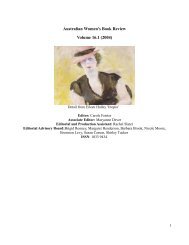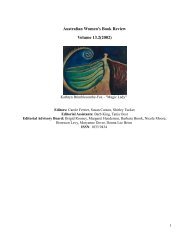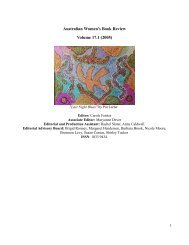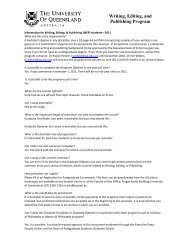Australian Women's Book Review Volume 14.1 - School of English ...
Australian Women's Book Review Volume 14.1 - School of English ...
Australian Women's Book Review Volume 14.1 - School of English ...
Create successful ePaper yourself
Turn your PDF publications into a flip-book with our unique Google optimized e-Paper software.
In the first chapter Woollacott articulates what is in fact a self-evident point, but which I have not seen<br />
so clearly discussed before; that is that the ship itself was a signifier <strong>of</strong> modernity with developing<br />
attendant cultural rituals such as the dockside farewell and the on-board class distinctions; the long<br />
voyage entailed stops at exotic places (outposts <strong>of</strong> empire) where even the lowest class <strong>of</strong> passengers in<br />
steerage became transformed into colonial plutocrats in relation to the indigenous people they<br />
encountered at these colourful ports <strong>of</strong> call (vendors and rickshaw drivers, for example). Woollacott<br />
links these <strong>of</strong>ten temporary attitudes to a developing knowledge among travellers about an imperial<br />
hierarchy <strong>of</strong> colour and their own whiteness and gender in that hierarchy, a knowledge, however, which<br />
on most occasions merely served to reinforce pre-existing beliefs in racial divisions within <strong>Australian</strong><br />
society and the privileges <strong>of</strong> whiteness. She problematizes the issue <strong>of</strong> whiteness by drawing<br />
particularly on the work <strong>of</strong> several American scholars who discuss the structured invisibility <strong>of</strong><br />
indigenous peoples and the ways in which non-Anglo-Saxons are reduced to an undifferentiated other.<br />
Similarly the second chapter on settling into a new urban space draws on the work <strong>of</strong> historians and<br />
cultural studies scholars on the city and urbanization in the nineteenth century; in a section on 'Colonial<br />
Geographies: Mapping London' Woollacott notes that, for <strong>Australian</strong> women, London was a place <strong>of</strong><br />
particular geographic and social spaces according to their interests and work. The subsequent two<br />
chapters record the establishment <strong>of</strong> colonial networks and organizations in London and the challenge<br />
to a masculinist culture which these represented. The strength and sense <strong>of</strong> communal solidarity which<br />
such organizations engendered - such as the feminist focus in the Lyceum Club and the British<br />
Commonwealth League and their commitment to female suffrage - furthered a growing sense <strong>of</strong> a<br />
coexisting national and imperial identity, sometimes at odds (resentment at being labelled 'colonial'),<br />
sometimes enabling a robust criticism <strong>of</strong> the imperial centre and its masters. Being seen as physically<br />
(and sexually) active, and embodying political freedom also (having won the federal vote in Australia<br />
in 1902), <strong>Australian</strong> women were seen as bearers <strong>of</strong> modernity, both in London and when they returned<br />
to Australia (particularly artists and musicians who participated in and brought back techniques and<br />
ideas <strong>of</strong> European modernism), in much the same way as Woollacott has argued in previous work for<br />
women munitions workers in the First World War as symbols <strong>of</strong> modernity. Nevertheless her claims for<br />
the potency <strong>of</strong> <strong>Australian</strong> women as equally symbols <strong>of</strong> modernity appear at times to be at once selfendorsing<br />
(different, adventurous, therefore modern) and historically disproportionate. Rather the<br />
strength <strong>of</strong> this study lies in its use <strong>of</strong> multiple and wonderfully diverse source materials to support the<br />
complex argument about colonialism and modernity and the role played by <strong>Australian</strong> women<br />
travellers in these historical movements.<br />
Dr Barbara Garlick taught for many years in the <strong>English</strong> Department at the University <strong>of</strong><br />
Queensland where she is now a Research Associate.<br />
29








